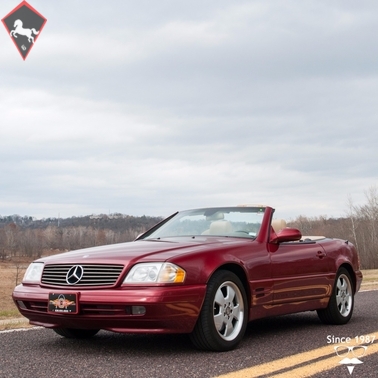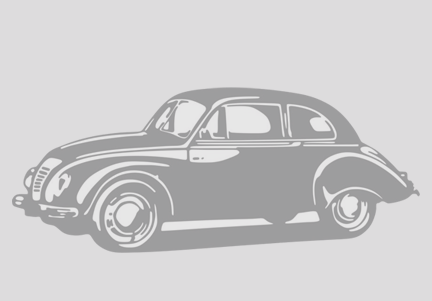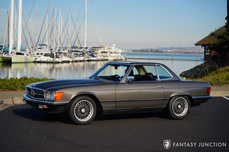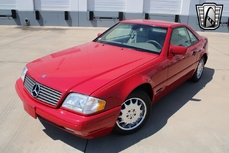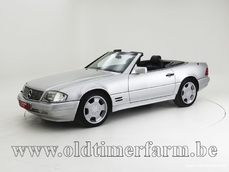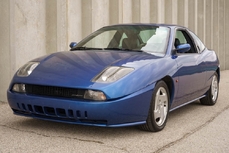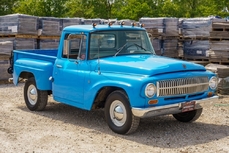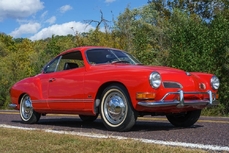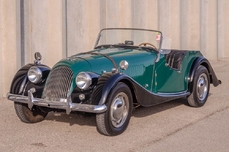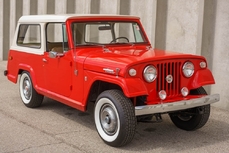Mercedes-Benz 500SL r129 5.0L V-8 1999
General description :
1999 Mercedes-Benz SL500
5.0L 24-valve SOHC V-8 engine (M113) with sequential fuel injection
5G-Tronic five-speed automatic transmission
Firemist Red exterior (code DB548) with Java power-folding soft-top (code 745) body color hardtop and Saffron Nappa leather interior (code 234A)
Power steering, power four-wheel disc brakes, power windows, power locks, power adjustable seats with heat and memory functions, power antenna, xenon headlights
Automatic climate control and cruise control, six-disc CD changer mounted in trunk
Dual front and side airbags, anti-lock brakes and electronic stability control
Service receipts for over $25,000.00 by Auto Europa of Naples Florida from 3/2009 through 1/2017.
Innovation, style and looking cool without trying those are the hallmarks of this 1999 Mercedes-Benz SL500 here at MotoeXotica Classic Cars. This example was built in Mercedes-Benzs Bremen, Germany factory in November 1998 and was delivered in the United States on December 9, 1998.
Finished in Firemist Red (code DB548) the cars paint and trim are in very good overall shape with only a minor blemish on the passenger side at the front air dam. The cars glass panels are clear and intact while the vehicles lights are in one piece and haze-free. This car rolls on Michelin radials, size 245/45ZR17 at all four corners. Each tire is wrapped around five-spoke AMG wheels and both tires and wheels look great.
This cars bodywork is straight and the doors and trunk close with the usual bank vault solidity. The Java-colored power-folding soft-top (code 745) had a surprise safety extra, a pop-up rollbar that automatically activated if the car sensed a rollover condition The trunk is in very good order, including the six-disc CD changer tucked away on the drivers side. The engine bay is extremely tidy and the cars bumpers fit tightly to the body. The car was consistently maintained by Auto Europa of Naples, Florida where it spent most of it’s life. We have receipts in hand for tune-ups, required services, fluid flush, A/C repair, seat panel replacement, water pump, top service and much more at a cost of over $25,000.00!
In that clean engine bay is the M113 5.0L 24-valve SOHC V-8 engine with sequential fuel injection and mated to a 5G-Tronic electronically controlled five-speed automatic transmission. Driver convenience features are abundant power steering, power four-wheel disc brakes, power windows, power door locks, power adjustable bucket seats with heat and memory functions, power antenna, automatic climate control, cruise control and electronic stability control. The cars power sideview mirrors are inoperable.
Inside, this Benz offers a Saffron leather interior (code 234A). The bucket seats, matching carpeting and headliner in the hardtop are all in very good overall shape. The instrument panel, with its full instrumentation, is in one piece and looks great. The factory four-spoke steering wheel is present and looks fine. The inner door panels, mirror glass, center console and gear selector are all in similar, very good order. This car comes with driver and passenger front airbags as well as side-mounted airbags. Completing the interior is a factory AM/FM stereo with CD slot and digital audio links to CD player instead of analog copper.
The SL500, or R129, was produced as a two-door, two-seatroadsterwith an automated (electro-hydraulic), collapsibletextile roof, with a shell-like, color-matched,tonneau cover. All R129s came standard with an aluminumdetachable hardtopthat was fitted by folding the canvas roof down and manually attaching the hardtop.
Designed in 1984, the R129 was based on the shortened floorpan of theMercedes-Benz W124 and featured many innovative details for the time, for instance electronically controlled damping (Adaptive Damping SystemADS, optional) and a hidden, automatically extending roll-over bar. The previous models somewhat dated rear suspension with semi-trailing arms gave way to a modern multi-link axle. The number of standard features was high, with electric action for the windows, mirrors, seats and hydraulic convertible top.
Competition to this Benz in 1999 included Acuras NSX, Aston Martins DB7 Volanté, BMWs M3 Convertible, Chevrolets Corvette Convertible, Hondas S2000 Convertible, Jaguars XK8 Drophead Coupe and Nissans 300ZX Convertible.
This car is currently located at our facility in St. Louis, Missouri. Current mileage on the odometer shows 101,980 miles. It is sold as is, where is, on a clean and clear, mileage exempt title. GET OUT AND DRIVE!!!
PLEASE CLICK HERE TO VIEW OUR YOU TUBE VIDEO!
Please Copy & Paste the Link Below to Watch the Video:
http://www.youtube.com/watch?v=ZfXN8E4HlRQ
VIN: WDBFA68F4XF179216 EIN: 113961 30 043662 TIN: 722624 01 257740
https://www.motoexotica.com/inventory/listing/1999-mercedes-benz-sl500-convertible/
1999 Mercedes-Benz 500SL r129 5.0L V-8 is listed sold on ClassicDigest in Fenton (St. Louis) by for $13900.
Car Facts
Car type : Car Make : Mercedes-Benz Model : 500SL r129 Model Version : 5.0L V-8 Engine size : 5.0 Model Year : 1999 Sub type : Convertible Location : Fenton (St. Louis)
Sold
Seller Information
Sold
People who viewed this Mercedes-Benz 500SL r129 also viewed similar Mercedes-Benz listed at ClassicDigest
Other cars listed for sale by this dealer
About Mercedes-Benz
In the annals of automotive history, the journey of Mercedes-Benz is a tale that unfolds with the ingenuity of its founding pioneers. In the year 1886, Karl Benz crafted the Benz Patent Motorwagen, a creation that would go down in history as the world's inaugural automobile. Unbeknownst to him, this moment marked the genesis of what would evolve into the most illustrious premium car manufacturer globally. The financial underpinning of this pioneering venture, interestingly, was provided by Karl Benz's wife, Bertha Benz, demonstrating a remarkable partnership that would set the tone for Mercedes-Benz's legacy.A parallel narrative emerged not far away, as Daimler-Motoren-Gesellschaft, founded by Gottlieb Daimler and Wilhelm Maybach, entered the scene. In 1901, they unveiled their automobile under the now-famous moniker "Mercedes," meaning "godsend" in Spanish. This name was bestowed upon the car at the behest of Emil Jellinek's daughter, the distributor for Daimler-Motoren-Gesellschaft. The wheels of innovation were set in motion.
Fast forward to 1926, a pivotal year that witnessed the merger of Daimler with Benz & Cie., culminating in the birth of Daimler-Benz. The amalgamation saw the adoption of "Mercedes-Benz" as the distinguished trademark for their automobiles, fusing the legacies of two visionary entities into one.
Contrary to perceptions of conservatism, the trajectory of Daimler-Benz unfolds as a chronicle of industry firsts. From the introduction of the honeycomb radiator to the float carburetor, and the pioneering implementation of four-wheel brakes in 1924, Daimler-Benz consistently pushed the boundaries of automotive innovation. The diesel-powered Mercedes-Benz 260 D in 1936 marked the inception of diesel engines in passenger cars. The iconic Mercedes-Benz 300SL Gullwing made history as the first car with direct fuel injection, albeit the Gutbrod's tiny 2-stroke engine can claim precedence.
Safety innovations became a hallmark, with Béla Barényi's patented safety cell design in the "Ponton"-models in 1951, featuring front and rear crumple zones. The W116 450SEL 6.9 saw the introduction of the Anti-Lock Brake system (ABS), another pioneering safety feature. From the first production airbags and beyond, the legacy of "firsts" continued to be etched into the fabric of Daimler-Benz.
Over its centennial journey, Mercedes-Benz has not merely produced cars but has sculpted automotive icons. The SSKL, 710 SSK Trossi Roadster, 770K Grosser, 540K Spezial Roadster, 300SL Gullwing, w100 600 Pullman, w111 280SE 3.5 Flachkühler, w113 230SL Pagoda, w109 300 SEL 6.3, and w201 2.3-16 Cosworth stand testament to the brand's commitment to engineering excellence.
The roaring Silver Arrows, or "Silberpfeile," including the W 25, W 125, W154, W165, and W196, created a legacy of dominance on the racetrack. These machines were not merely cars; they were expressions of precision, speed, and an indomitable spirit that left their competitors in the dust.
As Mercedes-Benz marches into the future, it does so not just as an automaker but as a custodian of a legacy, a torchbearer of innovation, and a beacon of automotive excellence. The road ahead is sure to witness the continued fusion of cutting-edge technology, timeless design, and an unwavering commitment to setting new standards in the world of automobiles.
One luminary figure who left an indelible mark was Béla Barényi, often heralded as the "father of passive safety" for his pioneering work in safety engineering. His patented safety cell design, featuring front and rear crumple zones, became a hallmark of Mercedes-Benz's commitment to occupant safety, setting new standards that reverberated throughout the automotive world.
Moving through the chronicles, the collaborative genius of Wilhelm Maybach, alongside Gottlieb Daimler, laid the foundation for Daimler-Motoren-Gesellschaft. Their innovations not only birthed the first Mercedes but established a culture of relentless pursuit of technological excellence that remains integral to Mercedes-Benz's DNA.
In the post-merger era of 1926, Ferdinand Porsche emerged as a prominent figure within Mercedes-Benz. His work on the Mercedes-Benz S-Type, a supercharged race car, garnered acclaim and set the stage for a legacy that extended far beyond the marque. Porsche's impact would later extend to his eponymous company, but his influence at Mercedes-Benz during those formative years was pivotal.
As the 20th century progressed, the legendary Rudolf Uhlenhaut emerged as a key figure. Uhlenhaut, an accomplished engineer and the driving force behind the iconic Silver Arrows, played a crucial role in Mercedes-Benz's dominance in motorsports. His engineering prowess and attention to detail were instrumental in creating some of the most formidable racing cars of the era.
In the latter half of the century, figures like Bruno Sacco, the head of design at Mercedes-Benz from 1975 to 1999, left an indelible imprint on the brand's aesthetic identity. Sacco's design philosophy, characterized by clean lines and timeless elegance, shaped iconic models like the W126 S-Class and the W201 190E, solidifying Mercedes-Benz's reputation for luxury and sophistication.
The narrative would be incomplete without acknowledging the contributions of engineers like Hans Scherenberg, whose leadership in the 1970s ushered in a new era of technological innovation at Mercedes-Benz. Scherenberg's tenure saw the development of groundbreaking technologies, including the Anti-Lock Brake system (ABS) and the introduction of airbags in production cars.
